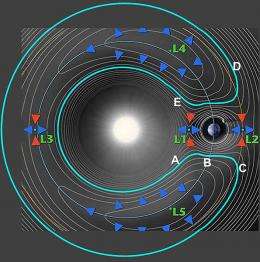April 6, 2011 report
New horseshoe orbit Earth-companion asteroid discovered

(PhysOrg.com) -- Apostolos Christou and David Asher from the Armagh Observatory in Northern Ireland announced the discovery of an asteroid near Earth called Asteroid 2010 SO16 and their findings were published on arXiv.org. While finding near-Earth asteroids is not unusual, there is something quite rare about this particular asteroid in that it orbits the sun in what is referred to as a horseshoe orbit.
A horseshoe orbit gets its name because when viewed from Earth’s point of view, the asteroid appears to travel in a shape of a horseshoe. However, from the perspective of the asteroid, it is in a continual orbit around the sun.
To better understand this horseshoe orbit it must be understood that objects closer to the sun will orbit at a faster rate than objects of a further distance.
Imagine this asteroid is on an orbit around the Sun just slightly closer than that of Earth. Given the fact the asteroid is closer it is traveling at a slightly faster rate than Earth. Eventually the asteroid will approach Earth and what happens next is what gives the appearance of a horseshoe.
Given that the Earth is larger its gravity will work to pull the asteroid away from the Sun, eventually pulling the asteroid into an orbit which is a greater distance from the sun than Earth. The asteroids new orbital track will then be slower than that of Earth, making it appear to fall behind and look as though it is going in the opposite direction.
As both the Earth and the asteroid continue to orbit, eventually the Earth will catch up to the asteroid and the process will reverse, with the Earth’s gravity pulling the asteroid back into the smaller orbit.
The belief of astronomers has been that horseshoe orbits are not stable. However, Christou and Asher have run simulations and they show that SO16 remains in this horseshoe orbit for anywhere from 120,000 to over a million years.
Currently SO16 is traveling at one of its closest approach points and will hold a place in the evening sky for several decades to come.
More information:
A long-lived horseshoe companion to the Earth, arXiv:1104.0036v1 [astro-ph.EP] arxiv.org/abs/1104.0036
via Technology Review
© 2010 PhysOrg.com



















